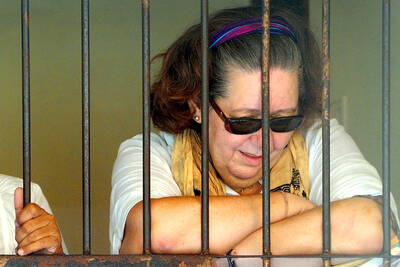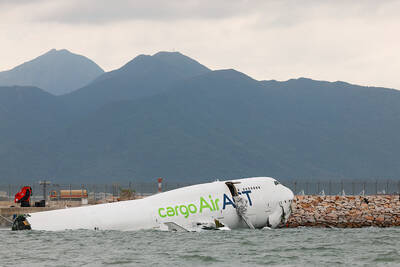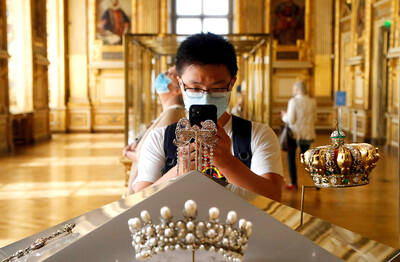Shanghai and other big Chinese cities, including Shenzhen, have ramped up testing for COVID-19 as infections rise, with some local authorities hastily closing schools, entertainment venues and tourist spots.
Infections have risen to the highest since August, with the uptick coming after increased domestic travel during China’s seven-day National Day holiday earlier this month.
Authorities reported 2,089 new local infections for Monday yesterday, the most since Aug. 20.

Photo: Reuters
While many of the cases were found in tourist destinations, including scenic spots in the northern region of Inner Mongolia, megacities that are often the source of well-heeled and well-traveled tourists have started to report more cases this week.
Shanghai, China’s financial capital of 25 million people, reported 28 local cases for Oct. 10, the fourth day of double-digit increases.
Keen to avoid a reprise of the economically and psychically scarring lockdown in April and May, Shanghai said late on Monday that all of its 16 districts were to conduct routine testing at least twice a week until Nov. 10.
That is a step up from once a week, a regime imposed after the last lockdown.
Checks on inbound travelers and in places such as hotels should also be bolstered, authorities said.
The expanding web of measures have already ensnared some.
Peter Lee, a long-time British expatriate, was out at lunch with his wife and seven-year-old son last week when he was notified his apartment block was to be locked down for 48 hours.
Lee and his son checked into a hotel, which was then also locked down due to a prior visit by a COVID-19 case.
Lee’s wife, who was planning to join them, had no choice but returned home to be locked in, and then had her lockdown extended.
Lee and his son are due to be released tomorrow, while Lee’s wife is not to be released until Sunday.
“It might be that we say, we miss home and we miss mum too much and maybe we just go home and just deal with it, but we also lose another weekend then,” Lee said. “We’re monitoring the situation, because it seems like Shanghai is gradually shutting down anyway, and if everything starts to close then there won’t be much benefit in being able to come and go.”
As of Monday, 36 Chinese cities were under various degrees of lockdown or control, affecting abotu 196.9 million people, versus 179.7 million in the previous week, Nomura Holdings said.
In China’s southern tech hub of Shenzhen, where the highly transmissible Omicron BF.7 subvariant of SARS-CoV-2 has surfaced, local cases more than tripled to 33 on Monday from a day earlier.
Inbound travelers are to be subject to three tests over three days, authorities in the city of 18 million people said yesterday.
Despite China’s very small caseload versus the rest of the world, and the toll its counter-epidemic policies exact on the economy and population, the government has repeatedly urged people to accept the measures.
“Once a large-scale rebound occurs, the epidemic will spread, and is bound to have a serious impact on economic and social development, and the final price will be higher and losses will be greater,” the state-controlled People’s Daily wrote in a commentary yesterday.
The COVID-19 preventive steps come days ahead of a Chinese Communist Party National Congress starting on Sunday where Chinese President Xi Jinping (習近平) is expected to extend his leadership.

Indonesia was to sign an agreement to repatriate two British nationals, including a grandmother languishing on death row for drug-related crimes, an Indonesian government source said yesterday. “The practical arrangement will be signed today. The transfer will be done immediately after the technical side of the transfer is agreed,” the source said, identifying Lindsay Sandiford and 35-year-old Shahab Shahabadi as the people being transferred. Sandiford, a grandmother, was sentenced to death on the island of Bali in 2013 after she was convicted of trafficking drugs. Customs officers found cocaine worth an estimated US$2.14 million hidden in a false bottom in Sandiford’s suitcase when

CAUSE UNKNOWN: Weather and runway conditions were suitable for flight operations at the time of the accident, and no distress signal was sent, authorities said A cargo aircraft skidded off the runway into the sea at Hong Kong International Airport early yesterday, killing two ground crew in a patrol car, in one of the worst accidents in the airport’s 27-year history. The incident occurred at about 3:50am, when the plane is suspected to have lost control upon landing, veering off the runway and crashing through a fence, the Airport Authority Hong Kong said. The jet hit a security patrol car on the perimeter road outside the runway zone, which then fell into the water, it said in a statement. The four crew members on the plane, which

Japan’s ruling Liberal Democratic Party (LDP) and its junior partner yesterday signed a coalition deal, paving the way for Sanae Takaichi to become the nation’s first female prime minister. The 11th-hour agreement with the Japan Innovation Party (JIP) came just a day before the lower house was due to vote on Takaichi’s appointment as the fifth prime minister in as many years. If she wins, she will take office the same day. “I’m very much looking forward to working with you on efforts to make Japan’s economy stronger, and to reshape Japan as a country that can be responsible for future generations,”

SEVEN-MINUTE HEIST: The masked thieves stole nine pieces of 19th-century jewelry, including a crown, which they dropped and damaged as they made their escape The hunt was on yesterday for the band of thieves who stole eight priceless royal pieces of jewelry from the Louvre Museum in the heart of Paris in broad daylight. Officials said a team of 60 investigators was working on the theory that the raid was planned and executed by an organized crime group. The heist reignited a row over a lack of security in France’s museums, with French Minister of Justice yesterday admitting to security flaws in protecting the Louvre. “What is certain is that we have failed, since people were able to park a furniture hoist in the middle of